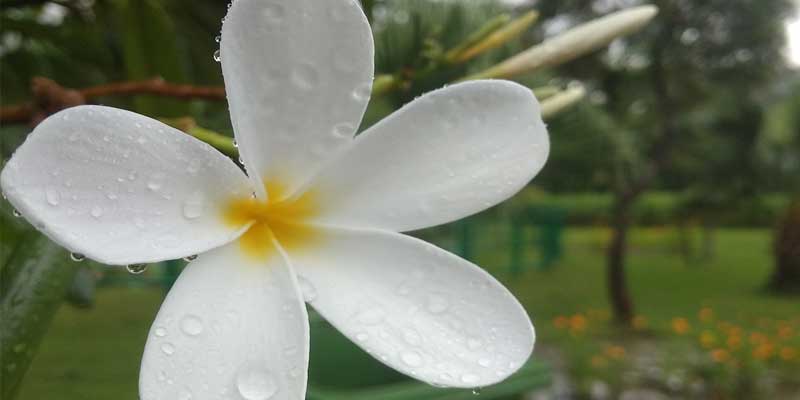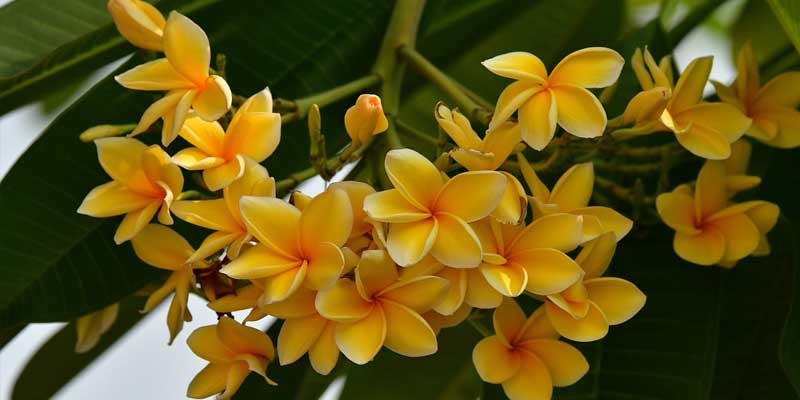Renowned for its vibrant, aromatic flowers; Plumeria – commonly referred to as frangipani – is a tropical beauty. Its exotic appeal and delightful fragrance have made it popular in gardens, balconies, and landscapes across both tropical and subtropical regions. Understanding the watering requirements of these stunning plants becomes paramount to guarantee their health and vitality. Nurturing robust plumerias and encouraging abundant blooms hinge on the key aspect of proper hydration.
This comprehensive guide delves into the art of watering plumeria plants: it explores frequency, techniques, and factors that influence watering schedules.
The Importance of Watering Plumeria Plants
Like many tropical species, plumerias thrive in environments with adequate moisture levels; their resilience – a remarkable trait – enables them to tolerate periods of drought. To maintain the health and vigor of plumeria plants, one must understand the crucial balance between hydration and drainage.
Not only does proper watering sustain their growth, but it also promotes flowering and reduces the risk of diseases; furthermore, it minimizes stress-related issues.
4 Factors Influencing Watering Frequency
Several factors influence the frequency of watering plumerias:
1. Climate and Season
Plumeria’s watering needs fluctuate with climate and seasonal alterations. During warmer months or under intense sunlight exposure, the need for more frequent watering arises as a compensation measure against heightened evaporation rates.
Conversely, in cooler seasons or during dormancy, their water requirements diminish.
2. Soil Type and Drainage
Plumerias flourish in well-draining soil, which facilitates the easy escape of excess water; however, heavy or waterlogged soil may induce root rot and other issues related to moisture.
Sandy, loamy soil with good aeration facilitates proper root development and prevents waterlogging.
3. Container Planting vs. Ground Planting
Plumerias in containers might necessitate more frequent watering than their counterparts directly rooted in soil. During hot weather, container-grown plants may quickly dry out due to their limited access to soil moisture.
4. Plant Size and Growth Stage
Young plumerias, along with recently transplanted specimens, due to their nascent root systems and the need for acclimation in a novel environment, typically demand more frequent watering.
Mature plants, boasting well-established roots; exhibit higher levels of tolerance towards drought yet still derive benefits from regular hydration – this is especially true during phases of flowering and growth.
Guidelines for Watering Plumeria Plants
Before you water, observe the soil moisture level. Plumerias favor a slight dryness, which is an interim condition between successive watering sessions. So, evaluate and ensure optimal hydration for your plants accordingly.
1. Dryness Of Soil: If you insert a finger into the soil, it can assist in determining the necessity of watering. When the soil at a depth of 1-2 inches feels dry upon touch, that is an indicator to commence with water application.
2. Growth Period: During active growth periods, ensure thorough watering of plumerias every 7-10 days; adjust this frequency according to environmental conditions and soil moisture levels. To avert waterlogged soil and root rot in cooler weather or during dormancy, decrease the watering frequency.
3. Watering Technique: Directly apply water to the root zone of plumerias instead of overhead. Moisture efficiently penetrates the soil and reaches the roots when you water at the base of a plant. Avoid wetting the foliage excessively, as prolonged moisture can promote fungal diseases.
4. Deep Watering: Facilitate comprehensive hydration by permitting water to deeply infiltrate the soil; apply it slowly with a consistent distribution around the plant’s base until saturation of soil occurs, ensuring sufficient dampness. Deep watering encourages deep root growth and enhances plant resilience to drought conditions.
5. Mulch: Mulching augments soil moisture retention, suppresses weed growth, and regulates soil temperature around plumeria plants. Around the base of the plant – but with an intentional gap left around its stem to prevent rotting – apply a layer of organic mulch; wood chips or compost are excellent options for this purpose.
6. Monitor Weather Conditions: Mind the weather forecasts and heed seasonal changes in adjusting your watering schedule. Hot, windy days intensify water loss through evaporation; thus, they demand more frequent watering. Conversely, cooler overcast days might necessitate a decrease in moisture requirements.
7. Avoid Overwatering: Plumeria care frequently falls victim to overwatering, a prevalent mistake; this can trigger root rot, and instigate fungal diseases – ultimately compromising the plant’s health. To circumvent waterlogged conditions—let the soil dry out marginally between each watering session.
8. Drainage Considerations: Select pots that drain well and amend heavy soil with perlite, sand, or compost to enhance aeration and water flow; this will ensure proper drainage. Further, elevate containers equipped with drainage holes to prevent water accumulation at the bottom which ultimately minimizes root suffocation risk.
Conclusion
Striking a delicate balance between hydration and moderation is crucial in mastering the art of watering plumeria plants. Understanding the factors that influence their water requirements, and adopting appropriate practices—these steps allow you to cultivate flourishing plumerias with lush foliage and exquisite blooms become your rewards.
To sustain this tropical treasure’s health and beauty, integral actions include regular monitoring of soil moisture; attentive observation noticing any changes in plant behavior, and responsiveness to environmental cues are necessary.
Your plumeria plants, when you provide them with proper care and attention, will enchant you season after season as they flourish their splendor remaining a constant source of awe.



Leave a Reply